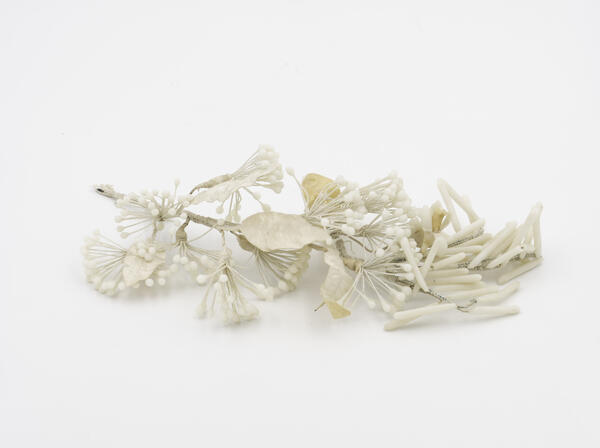A wedding is one of the most important family rituals that formalize marriage and the creation of a new family. At different times and in different cultures, there have been different features and essential attributes of this rite. Even the smallest details were of great importance — including the bride’s festive decorations. Flowers are considered one of the indispensable attributes of a wedding dress. The museum collection contains a sprig of orange blossom from the early 20th century.
Initially, this was the name of the orange tree blossoms, which served as part of the bride’s wedding dress in different countries. They could be woven into a crown, decorate a dress or make a wedding bouquet. In many countries, the white flowers of orange blossom symbolize purity and virginity.
According to Greek mythology, on the eve of the wedding, the god of thunder Zeus presented his future wife Hera with a beautiful orange garden as a gift. She decided to use the gift of her chosen one to keep his love for many years. In order to attract Zeus, who had a passion for young beauties, Hera visited the orange grove every day and inhaled the fragrance of blooming flowers. This ritual restored her youth and beauty.
In Christianity, the orange blossom symbolizes both innocence and fertility and is thus considered a symbol of Immaculate Conception. This metaphor is related to the fact that orange flowers and fruit can appear on the same tree at the same time.
The very custom of using orange tree blossoms in a wedding ceremony originated in England in the 17th century. At that time, these flowers began to be attached to the veil and hem of wedding the ladies of the court. The fashion for wild orange flowers was revived by Victoria, Queen of Great Britain, who in 1840 married Prince Albert wearing a veil decorated with orange blossom and ornaments with elements of these flowers. Fleur d’orange became an integral element of royal weddings.
Soon the tradition spread throughout Europe and reached Russia. However, in our country, orange flowers were rare and expensive. Not every girl could afford them. Therefore, artificial flowers made of wax, satin, paper, and other materials were used to replace them.
Only a girl who was getting married for the first time had the right to a crown of orange flowers. Widows and women who were married for the second time decorated themselves with roses and lilies of the valley. The tradition of decorating the bride’s dress or her hairdo with orange blossom has been preserved in our time.
Initially, this was the name of the orange tree blossoms, which served as part of the bride’s wedding dress in different countries. They could be woven into a crown, decorate a dress or make a wedding bouquet. In many countries, the white flowers of orange blossom symbolize purity and virginity.
According to Greek mythology, on the eve of the wedding, the god of thunder Zeus presented his future wife Hera with a beautiful orange garden as a gift. She decided to use the gift of her chosen one to keep his love for many years. In order to attract Zeus, who had a passion for young beauties, Hera visited the orange grove every day and inhaled the fragrance of blooming flowers. This ritual restored her youth and beauty.
In Christianity, the orange blossom symbolizes both innocence and fertility and is thus considered a symbol of Immaculate Conception. This metaphor is related to the fact that orange flowers and fruit can appear on the same tree at the same time.
The very custom of using orange tree blossoms in a wedding ceremony originated in England in the 17th century. At that time, these flowers began to be attached to the veil and hem of wedding the ladies of the court. The fashion for wild orange flowers was revived by Victoria, Queen of Great Britain, who in 1840 married Prince Albert wearing a veil decorated with orange blossom and ornaments with elements of these flowers. Fleur d’orange became an integral element of royal weddings.
Soon the tradition spread throughout Europe and reached Russia. However, in our country, orange flowers were rare and expensive. Not every girl could afford them. Therefore, artificial flowers made of wax, satin, paper, and other materials were used to replace them.
Only a girl who was getting married for the first time had the right to a crown of orange flowers. Widows and women who were married for the second time decorated themselves with roses and lilies of the valley. The tradition of decorating the bride’s dress or her hairdo with orange blossom has been preserved in our time.



